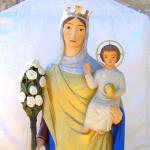
There’s an old Italian joke that goes, “What’s the best thing about Milan? The train back to Rome”.
When viewing the country’s splendour as a broader package, it’s easy to grasp why Milan is not anyone’s first destination on their Italian itinerary. The art of Florence, the cuisine of Bologna, the history of Rome, the canals of Venice, and the tragedy of Pompeii are just some of the tourist hot spots prioritised above Italy’s second-most populous city. This oversight is a shame, as Milan carries many boasting points in its own right, such as its globally recognised fashion culture, successful football power, and seemingly endless Leonardo da Vinci-related sales pitches.
But beneath the obvious lies the secret underbelly of the megalopolis. You have to earn it, but once you learn how to approach Milan from peculiar angles, it suddenly rolls over, exposing a darkness lurking in its pores that only you can see but never unsee. And eventually, you may acknowledge Milan as one of the world’s creepiest cities.
Don’t believe me? Visit these ten locations, and then we can chat.
10. The Skeletal Arrangements of San Bernardino alle Oss

Completed in 1776, the San Bernardino alle Oss appears like an ordinary Roman Catholic house of worship upon first entrance. However, one quick swivel into their attached chapel, and you may change your mind. Because of the walls. They are decorated with thousands of human bones.
Where some see a problem, others see an opportunity. The church conceived this macabre plan after their cemetery ran out of ground to bury the dead. Instead of getting upset, they turned the issue into an art project, placing the skulls and tibiae into pretty patterns for the world to enjoy. They became so obsessed with the undertaking that they started actively seeking bones to complete the room, eventually receiving sponsorship from local hospitals and prisons.
In the end, they accomplished a fantastic job in a morbidly gorgeous way. So much so, that it inspired King John V of Portugal to construct an identical one for himself in Évora, near Lisbon.
09. The Skinless Saint of Milan Cathedral
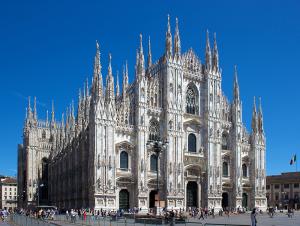
Everywhere needs a primary landmark, and in Milan, there is no competition against Duomo di Milano (Milan Cathedral). It took six centuries to finish this architectural masterpiece, and it is recognised as the largest church in Italy (St. Peter’s Basilica is bigger, but Vatican City is a sovereign state), the second-largest in Europe, and the third-largest in the world. Unsurprisingly, it is the most visited tourist attraction Milan has to offer.
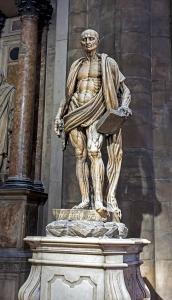
But the devil hides within the details, of which the Duomo has plenty. From demons to even a dinosaur carved into its walls, one could lose hours in the weirdness of this church’s epic presence. But you would not have to look very far to find its most famously bizarre piece: the sculpture of Saint Bartholomew without any skin.
As one of Jesus’ twelve apostles, Bartholomew met his demise when his opposers peeled him alive. This statue displays the man post-procedure, nothing but exposed muscle with his flayed skin flung over his shoulder. If such a brutal scene does not give you the heebie-jeebies, then maybe you should talk to a professional about that.
08. The Dark Art of Portinari Chapel
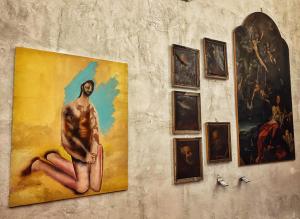
If there ever was a holy place where demon priests take off their masks to discuss global domination, this might be it. Completed in 1468, the architect is entirely unknown, but maybe it was Lucifer himself? The juxtaposition of modern and traditional artwork alone is enough to jiggle the nerves with the shivers. But if you want even more creep for your €6 entry fee, how about the marble shrine containing the head of St. Peter of Verona? But where’s the rest of his body? I have no idea, but we will revisit the man later, if you can handle it.
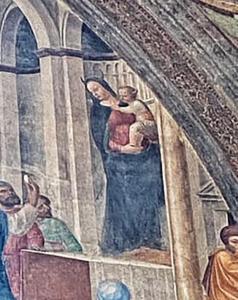
These examples are peanuts compared to Portinari Chapel’s ceiling fresco. There you’ll find the Mother Mary lovingly cradling baby Jesus, except… they both have Satanic horns protruding from their skulls. Apparently, this vision is based on a true story where demons appeared to trick the people as the Virgin and Son. However, St. Peter of Verona was so divine that he glimpsed the devil within them and chased those blasphemous imposters away. Regardless, it’s a disturbing sight, guaranteed to stir anyone’s blood, Christian or otherwise.
07. Disconcerting Sculptures in the Basilica of Sant’Eustorgio’s Crypt
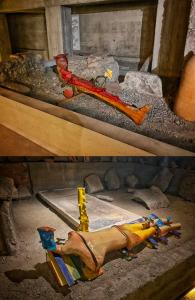
Portinari Chapel is situated inside of the less-freaky Basilica of Sant’Eustorgio. Still, this Basilica was once a historic pilgrimage location of its own, primarily because it housed the corpses of the Three Biblical Magis. These dead relics were discovered in Istanbul (then-Constantinople) around 314 and stashed within these grounds for safekeeping. Sadly, those figures are not here anymore, as Milan passed them onto Germany’s Cologne Cathedral in 1164. However, the associated crypt remains so disquieting that it earns this slot on our list.
It’s difficult to understand what you’re seeing here, but it appears to be surreal modern art sculptures positioned among the antique ruins. Even more confusing is how little information exists explaining the display. What was the thought behind this unnerving exhibition? Who did this? There’s a good chance that everyone is simply too afraid to ask.
06. The Brutally Attacked Statue of St. Peter of Verona
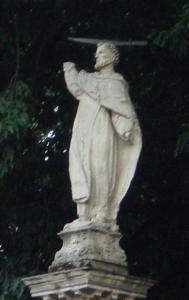
As if the above Basilica of Sant’Eustorgio and Portinari Chapel haven’t shaken us enough, there’s still one additional feature that completes this terrifying trinity. And that’s a sculpture outside these buildings, exhibiting St. Peter of Verona with a sword stuck into his head.
Peter was a 13th-century Catholic priest who preached across Italy, covering Rome, Florence, Bologna, and of course, Milan. He was an impressive leader who drew large crowds to his sermons, with many converts following. The Milanese Catharism team was not too pleased with his influence and decided the best move forward was to kill the man. They struck his skull with an axe, and he fell, only to stand up and recite the first article of the Apostles’ Creed. He died soon after.
Due to this strange tale, most artistic renditions of St. Peter feature a weapon wedged into his crown, such as a sword or a cleaver. Examples include (but are not limited to):
- Saint Peter the Martyr by Pedro Berruguete
- Baruffini San Pietro Martire
- Madonna and Child with St Peter Martyr by Lorenzo Lotto
- Friar Angelo Ferretti as Saint Peter Martyr by Lorenzo Lotto
- Stained glass window from St. Dominic’s Church in Washington, D.C.
- Saint Peter Martyr with Saints Nicholas and Benedict by Cima da Conegliano
- Saint Peter Martyr of Verona by Vittore Carpaccio
Another fun fact is that the Catholic Church recognised Peter as a saint 11 months after his death. This holds the record for the fastest canonisation in history! Nice work, Pete!
05. The Column Headbutted by the Devil
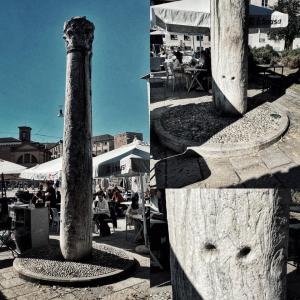
Saint Ambrose was the Bishop of Milan from 374 to 397. He is remembered as a hugely influential figure who fought against paganism in the city, ultimately recognised as the Patron Saint of Milan… and of beekeeping. That’s because a swarm of bees landed on his face as an infant, leaving only one drop of honey behind. Talk about a blessing.
It’s no wonder that The Devil had a keen interest in converting the man to the dark side, and the Evil Lord tried his luck outside where the Basilica of Sant’Ambrogio is today. Naturally, Ambrose was unflappable, causing Satan such distress that he headbutted the nearest marble column. And that is why you can find two dents in the surface here, left behind by the horns of Lucifer himself. Believe it or not, that is the official explanation. No one has ever challenged it.
04. Milano Centrale Railway Station’s Horrifying History
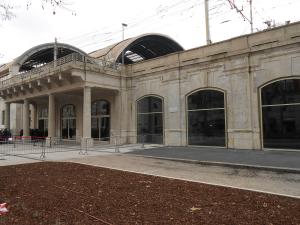
When talking about pure volume, Milan Centrale is the largest railway station in Europe, filled to capacity with the admiration of everyone. It is said that famed American architect Frank Lloyd Wright once called it “the most beautiful station in the world”, which is high praise from a high-up individual. However, there is a far darker tale to this location, which you knew was coming.
Platform 21. A secluded underground railway track that played a vile role during the Holocaust in Italy. Between 1943 and 1945, 1,200 Jewish people were forced onto a deportation train and sent to concentration camps like Auschwitz, Mauthausen, and Bergen Belsen. It is an ugly story within an even uglier story where followers of Judaism were murdered for their beliefs in one of the worst genocides in history. Thankfully, locations such as this now serve as a stern reminder of why we must never fall into these hateful ideologies again. Accordingly, Platform 21 is preserved as Memoriale della Shoah, a Holocaust memorial.
03. The Secrets of The Last Supper
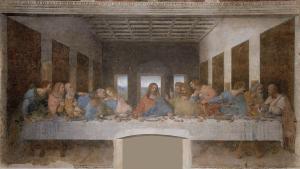
I know what you’re thinking. The Last Supper by Leonardo da Vinci? That’s one of the top five most recognisable paintings in the world! What could be so creepy about it?
Hidden symbolism! Scholars have spent centuries analysing the piece, and many intense theories have developed around almost every detail, whether da Vinci meant it or not. Here are some of the most fascinating proposals:
- Judas (fourth head from the left), who betrayed Jesus, is knocking over the salt with his elbow. Spilt salt is a sign of bad luck or perhaps loss. It may further allude to Jesus as the “salt of the earth”. Also, note that Judas clutches a small bag that holds his 30 pieces of silver for backstabbing his Lord.
- Peter (fifth head from the left) is holding a knife, a hint of things to come, as he later cuts off the ear of Malchus, a high priest’s servant.
- Made famous by the Da Vinci Code by Dan Brown, the femininity of John (left of Jesus) is said to be a sneaky representation of Mary Magedline, Jesus’ supposed lover at the time. Even if not, the cupped hands in the prayer position exhibit purity and devotion.
- Jesus’ hands are extra important, one reaching for bread (earth) and one open palm facing upwards (the divine).
- The 12 apostles are clearly in groups of three, a holy number in Christianity as the Trinity. It also creates space around Jesus as the focal point of the dinner (and everything).
- Finally, musician Giovanni Maria claims you can interpret the bread and hands as musical notes, presenting us with an eerie composition.
Simon (furthest right) is a silhouette of a human, which is not symbolic but a result of deterioration. For all his genius, Leonardo perhaps made the biggest mistake of his career by employing experimental techniques unsuitable for fresco materials. As a result, the piece was crumbling within two decades of completion, and there has been a flurry of restoration attempts since. It is said that less than 50% is Leonardo’s original work.
02. The Wall of the Dolls
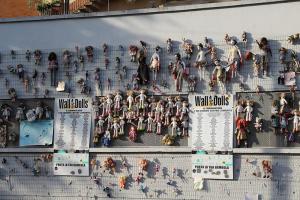
Stroll around the Ticinese district, and you’ll undoubtedly stumble across a striking sight you’ll never forget. That’s because, hanging in the open, is a vast collection of dolls of every size with a harrowing message to convey. No, it’s not one of voodoo intentions like you may think. Instead, it’s an installation raising awareness about violence against women.
Singer-songwriter Jo Squillo came up with the idea in 2014, using the broken dolls as a haunting symbol of feminine innocence lost. Each year, more figurines are added, along with dried flowers, heartbreaking poetry, and even the names of murdered women. The difficult-to-stomach factor is part of its importance, serving as a creative protest to encourage victims to stand up for themselves and take their power back.
01. The Witch of Via Laghetto 2
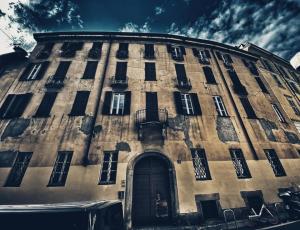
In the 1300s, the general public avoided the area around Via Laghetto 2 for numerous reasons. Firstly, it was known for its poverty which naturally generates decay and bad smells. But even more noteworthy was the story of one of their residents. Her name was Arima. And she was a witch.
According to legends, Arima was a loud resident, throwing outlandish parties, mixing strange potions, and dancing on the rooftops as she cackled to the moon. Locals were wary of such behaviour, but her reputation soon shifted when the scary sorceress became our tale’s hero.
From 1347 to 1351, the Black Death spread across Europe like a murderous blanket, claiming an estimated 200,000,000 lives. Milan was no different. Humans dropped to their demise every day, on every street. That is except for Via Laghetto, where not a single soul was infected. How was that possible? Nobody knows, but residents quickly attributed this miracle to our old pal Arima, and her myth as a good witch is cemented in Itlaino history forever.












